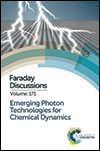Dynamics in next-generation solar cells: time-resolved surface photovoltage measurements of quantum dots chemically linked to ZnO (10![[1 with combining macron]](https://www.rsc.org/images/entities/char_0031_0304.gif) 0)
0)
Abstract
The charge dynamics at the surface of the transparent conducting oxide and photoanode material ZnO are investigated in the presence and absence of light-harvesting colloidal quantum dots (QDs). The time-resolved change in surface potential upon photoexcitation has been measured in the m-plane ZnO (10![[1 with combining macron]](https://www.rsc.org/images/entities/char_0031_0304.gif) 0) using a laser pump-synchrotron X-ray probe methodology. By varying the oxygen annealing conditions, and hence the oxygen vacancy concentration of the sample, we find that dark carrier lifetimes at the ZnO surface vary from hundreds of μs to ms timescales, i.e. a persistent photoconductivity (PPC) is observed. The highly-controlled nature of our experiments under ultra-high vacuum (UHV), and the use of band-gap and sub-band-gap photoexcitation, allow us to demonstrate that defect states ca. 340 meV above the valence band edge are directly associated with the PPC, and that the PPC mediated by these defects dominates over the oxygen photodesorption mechanism. These observations are consistent with the hypothesis that ionized oxygen vacancy states are responsible for the PPC in ZnO. The effect of chemically linking two colloidal QD systems (type I PbS and type II CdS–ZnSe) to the surface has also been investigated. Upon deposition of the QDs onto the surface, the dark carrier lifetime and the surface photovoltage are reduced, suggesting a direct injection of charge carriers into the ZnO conduction band. The results are discussed in the context of the development of next-generation solar cells.
0) using a laser pump-synchrotron X-ray probe methodology. By varying the oxygen annealing conditions, and hence the oxygen vacancy concentration of the sample, we find that dark carrier lifetimes at the ZnO surface vary from hundreds of μs to ms timescales, i.e. a persistent photoconductivity (PPC) is observed. The highly-controlled nature of our experiments under ultra-high vacuum (UHV), and the use of band-gap and sub-band-gap photoexcitation, allow us to demonstrate that defect states ca. 340 meV above the valence band edge are directly associated with the PPC, and that the PPC mediated by these defects dominates over the oxygen photodesorption mechanism. These observations are consistent with the hypothesis that ionized oxygen vacancy states are responsible for the PPC in ZnO. The effect of chemically linking two colloidal QD systems (type I PbS and type II CdS–ZnSe) to the surface has also been investigated. Upon deposition of the QDs onto the surface, the dark carrier lifetime and the surface photovoltage are reduced, suggesting a direct injection of charge carriers into the ZnO conduction band. The results are discussed in the context of the development of next-generation solar cells.
- This article is part of the themed collection: Emerging Photon Technologies for Chemical Dynamics

 Please wait while we load your content...
Please wait while we load your content...
![[1 with combining macron]](https://www.rsc.org/images/entities/h2_char_0031_0304.gif) 0)
0)